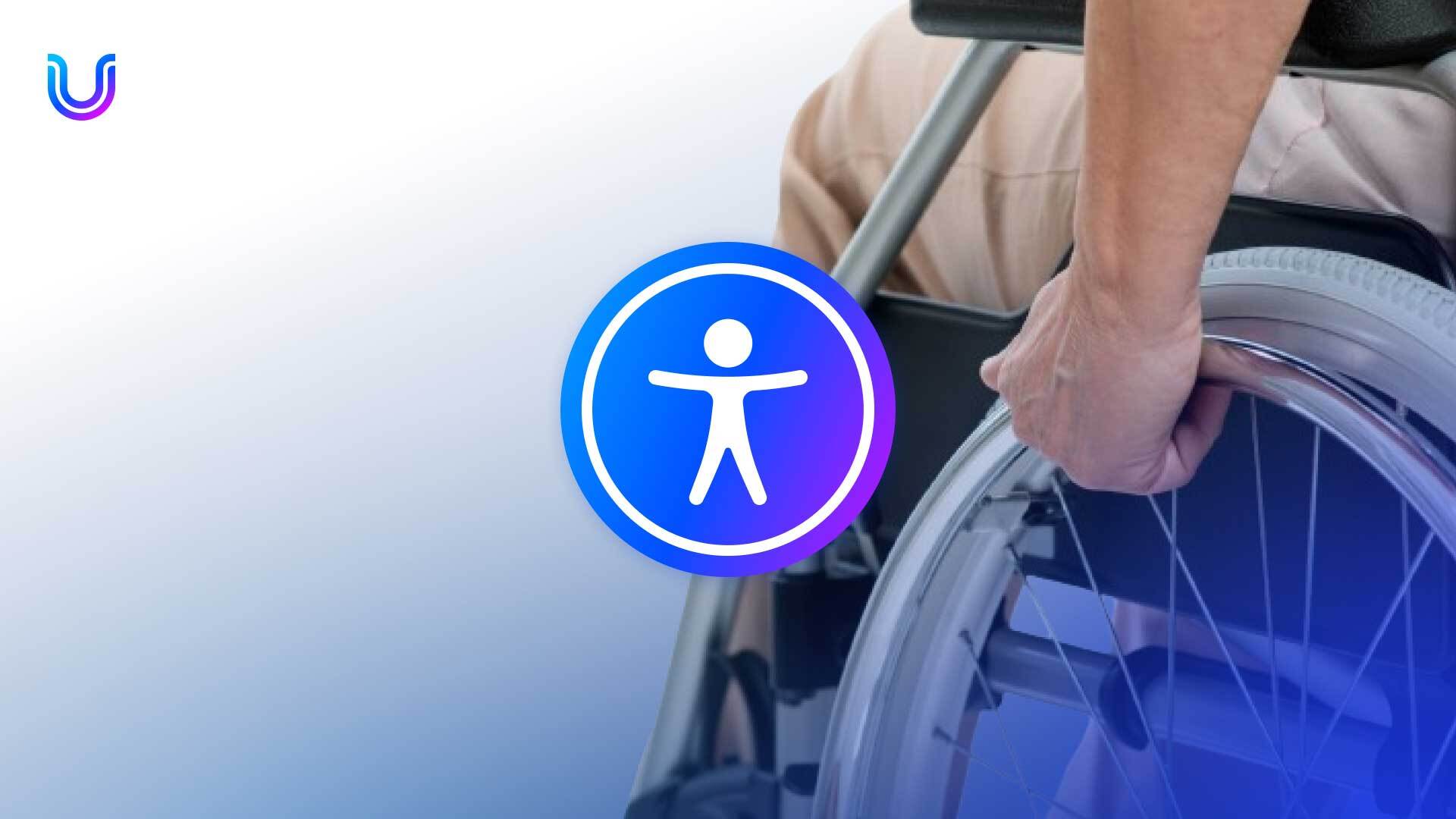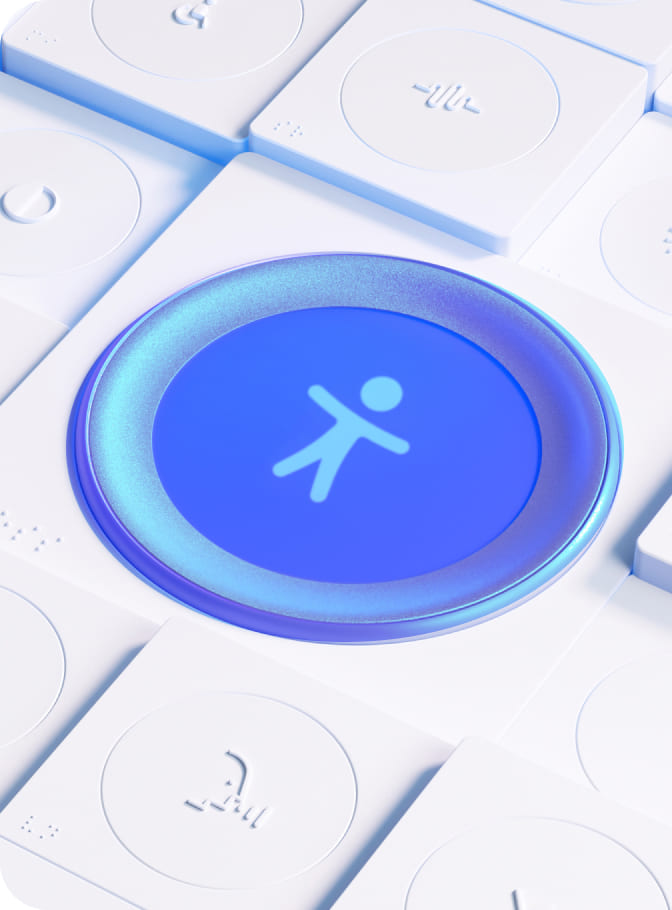Creating Accessibility for People With Mobility & Physical Disabilities

For people with mobility and physical disabilities, navigating the physical world often comes with its set of challenges. Curbs without ramps, buildings without elevators, and inaccessible public transport are just the tip of the iceberg.
These physical obstacles, both big and small, can impede access to everyday services and opportunities, highlighting a much bigger issue of inclusivity across our communities.
However, physical spaces aren’t the only places where barriers exist. The digital world presents similar challenges too.
Websites, apps, and digital platforms, much like their concrete counterparts, can present what can be seen as ‘virtual curbs’ – poorly designed user interfaces, lack of keyboard navigation, and content that’s inaccessible to screen readers.
These barriers prevent individuals with physical and mobility disabilities from fully engaging with digital content, participating in online communities, and accessing products and services that many of us take for granted.
So what can be done to bridge this gap? In this article, we’ll discuss how we can create digital spaces that welcome everyone, specifically people with mobility and physical disabilities.
Before we get started, you may be wondering what the difference is between mobility and physical disabilities. It’s true that mobility disabilities and physical disabilities are related concepts but they’re not exactly the same thing. Here’s a breakdown of the difference:
What are physical disabilities?
Physical impairments cover a broad range of conditions that affect a person’s physical capacity and/or mobility. This category can include issues related to limb function, muscle control, chronic pain, and other conditions that impact physical activities and daily living. Physical disabilities can affect various parts of the body and can be congenital (present from birth) or acquired due to injury, illness, or aging.
Did you know? Individuals with long-term physical conditions tend to report lower well-being scores compared to those without physical disabilities.
What are mobility disabilities?
Mobility impairments specifically refer to disabilities that affect movement. This can include difficulties with walking, climbing stairs, reaching, or moving from one place to another. In fact, mobility is the most common physical disability in the UK and US alike.
Mobility disabilities are a type of physical disability that affect a person’s ability to move around easily. Conditions leading to mobility disabilities can include paralysis, muscular dystrophy, amputations, and conditions like arthritis that specifically limit movement.
So, while all mobility disabilities are physical disabilities, not all physical disabilities are mobility disabilities. Physical disabilities can also include other types of impairments that do not necessarily affect movement, such as respiratory disorders, cardiovascular conditions, or chronic pain issues that impact other aspects of physical function.
Did you know? The Centers for Disease Control and Prevention (CDC) reports that one in four Americans lives with a disability that impacts their daily activities, with mobility disabilities being the most common, affecting 1 in 7 adults in the U.S.
What are different types of physical disability?
Physical disorders cover conditions impacting different parts of the body, each with its unique challenges and treatment approaches.
These physical disabilities include disorders like arthritis and osteoporosis impact bones, causing pain and mobility problems. Conditions such as cerebral palsy and multiple sclerosis affect the nervous system, disrupting movement and coordination. Heart issues like hypertension can risk overall health, while respiratory problems like asthma and COPD hinder breathing. Each disorder needs specific care to enhance life quality.
No matter the disability—long-term mobility issues, temporary impairments, or any physical condition – many people who have physical and mobility disabilities face obstacles online. This highlights the vital need for digital spaces that are accessible.
What are different types of mobility disabilities?
Mobility disabilities can make moving around tough, and each type of mobility impairment has its own challenges.
Some people have trouble with their bones and joints, like with arthritis or osteoporosis, making movement painful. Others might have conditions like cerebral palsy or multiple sclerosis that impact how their nerves work, affecting how they move and coordinate their actions. If a person has lost a limb or was born with differences in their limbs, they might need special equipment to help them get around.
How do people with physical impairments access the internet?
People with physical disabilities and folks who are mobility impaired access the internet using a variety of assistive technologies and adaptive strategies tailored to their specific needs.
These tools and methods are designed to overcome barriers that standard input devices (like a mouse and keyboard) and web interfaces may present. Here are some common ways people with physical disabilities navigate the digital world:
1. Screen readers: Software that reads out text displayed on the screen, used by people who have visual impairments as well as by individuals with certain physical disabilities that make reading text challenging.
2. Voice recognition software: Allows users to navigate, type, and control their computers or devices through voice commands. This is especially useful for people who have limited use of their hands.
3. Head pointers or mouth sticks: For those who cannot use their hands, head pointers or mouth sticks can be used to press keys on a keyboard or to navigate a touchscreen.
4. Eye tracking technology: Enables control of a computer or device through eye movements. This technology can be invaluable for individuals with severe mobility limitations, such as those with ALS (Lou Gehrig’s disease) or severe cerebral palsy.
5. Switch access: Switches can be activated by various body parts, allowing users with very limited mobility to navigate computers or devices. The switches can be programmed to perform specific actions like clicking, scrolling, or navigating through content.
6. Adaptive keyboards: Specialized keyboards that may have larger keys, alternative layouts, or customizable key functions to accommodate users with limited mobility or dexterity.
7. Sip-and-puff systems: Controlled by inhaling or exhaling, these devices translate breath actions into commands that can control a computer or wheelchair, suitable for individuals with significant physical limitations.
8. Modified or custom interfaces: Web browsers and websites can be customized with extensions and plugins to change text size, color contrasts, and navigation to accommodate various physical needs.
How do digital barriers impact people with physical and mobility disabilities?
Digital barriers can present massive obstacles for individuals with physical disabilities, limiting their access to vital information, services, and social interactions. These barriers arise in many forms across the digital world, bringing challenges to people that can prevent their full participation in the online world.
Navigation difficulties are a primary concern, as many websites and applications are designed with mouse-driven interfaces, neglecting users who depend on keyboard navigation or assistive technologies. This issue can make parts of a website hard to use for people with limited hand mobility.
The absence of alternative text for images, captions, or transcripts for multimedia content, and inaccessible controls can also make things harder, particularly impacting users who rely on screen readers or have hearing impairments.
How can you make web content more accessible for people with physical disabilities?
Let’s look at how we can elevate web accessibility for individuals with physical disabilities, ensuring our digital spaces are welcoming for everyone:
1. Dive into accessibility guidelines and law: Think of the Web Content Accessibility Guidelines (WCAG) as your roadmap to inclusivity. These guidelines, when properly followed, make your website easier for everyone to use, including people with disabilities. As web accessibility is a legal matter too, be sure to build your awareness of laws like the the Americans with Disabilities Act (ADA) and Section 508.
2. Conduct accessibility audits: Audits give your website an accessibility check-up. Conducting regular audits helps identify any barriers that might prevent people with physical disabilities from fully engaging with your content. It’s a proactive way to ensure your site remains open and usable for all.
3. Champion alternative text for images: Adding descriptive alt text to your images isn’t just about SEO; it’s a lifeline for users who rely on screen readers to browse the web. You’re essentially painting a picture with words for those who are unable to see your images directly. It means nobody misses out on the full experience of your site.
4. Use semantic HTML: This is all about using the right HTML elements for the right job. It helps everyone find what they’re looking for more easily. Semantic HTML sees that the structure of your web content is intuitive and aligned to sighted users and compatible with assistive technologies.
5. Prioritize keyboard navigation: Navigating the web without a mouse isn’t always easy for anyone, not least for people with physical disabilities. Make sure your site can be explored using just a keyboard. It gives your users with mobility impairments the independence they deserve, allowing them to explore your site at their own pace – and in their own way.
6. Caption and transcribe multimedia: Videos and podcasts are great channels for content, but without captions or transcripts, your users who may have hearing impairments are locked out of your work. Providing captions and transcripts unlocks your content, so everyone can enjoy your multimedia efforts.
7. Design readable text and layouts: Making your text readable and your layouts clear is the key to keeping your audience engaged. Use high contrast colors, legible fonts, and logical structure to make your content accessible to users with visual impairments.
8. Refine forms and input fields: Whether signing up for newsletters or purchasing products, your forms should be accessible to everyone. When building your forms, make sure each field is clearly labeled and provides clear instructions.
What should your next steps be?
When we talk about making the web more inclusive, especially for individuals with physical disabilities, user testing isn’t just beneficial—it’s essential. Unfortunately, It’s quite common for websites and digital platforms to be created by professionals without disabilities, who often don’t ask for input from people with physical disabilities on whether their design choices for websites or other digital platforms work well. Let’s discuss why user testing is a key part of the process when building accessibility into your websites.
The power of inclusive user testing
Testing with people of all abilities is key. When you let real users, including those with disabilities, try out your website or app, you get insights you can’t get anywhere else. It’s like they’re helping you see which parts of your digital maze work and which don’t.
Why it matters
Getting feedback from users with disabilities points out what needs fixing—things like hard-to-navigate menus or text that’s tough to read. It’s about making sure everyone can use your digital space easily.
Keep improving
This testing should keep happening, not just once. Every test round helps make your site or app better and more welcoming for everyone.
Understanding and empathy
Testing should help designers and developers really empathize with the challenges users with disabilities face. It’s about more than just following rules; it’s about creating something that works well for everyone.
Empowering users
Involving users with disabilities not only makes your product better but also shows you value their input. This builds trust and shows you’re serious about making digital spaces for everyone.
Testing with diverse users is good practice and essential for creating accessible, enjoyable digital experiences for all.
UserWay: for websites designed with accessibility in mind
At UserWay, it’s our mission to make the internet an accessibility place for everyone, no matter your ability. all. As a leader in the web accessibility field, we’re dedicated to helping businesses eliminate digital barriers and provide a seamless experience for every user.
So, if you’re a designer or web developer who hasn’t yet considered the needs of people with physical disabilities in your work, it’s never too late to start making a change. There are many steps to the process and that’s what the UserWay team is here for.
Our Accessibility Widget, (our most popular tool) is on over 1 million websites worldwide, and helps to identify and fix your accessibility errors, boosting site performance and getting you off to a strong start on your compliance journey. We also provide manual Accessibility Audits for thorough compliance checks, and developers love our accessibility scanning and monitoring services that remediate your accessibility-related issues in real time across your portfolio of sites.
The good news to remember is that designing for accessibility does not mean compromising on your aesthetics or innovation. In fact, it can actually result in more creative and thoughtful design solutions that benefit a wider audience. If you’d like to discuss how to easily build accessibility into your sites, get in touch and we’ll show you how our tools for accessibility all work!
FAQS
Which disabilities are most common?
Mobility and physical disabilities, touching lives with challenges like arthritis and spinal cord injuries, are widespread, affecting millions with their daily hurdles.
What’s a mistake designers make when building websites for people with mobility disabilities?
A common oversight made by designers is forgetting about keyboard navigation, which is a lifeline for people who navigate the digital world without a mouse.
What’s an unexpected benefit of digital accessibility for businesses?
A welcome surprise for businesses embracing digital accessibility is seeing a boost in SEO. Search engines like accessible websites, so, when designing accessible sites, you’re more likely to broaden your audience reach and welcome more visitors.
What does accessibility user testing involve?
Accessibility testing evaluates a software application’s usability for individuals with disabilities, such as those with hearing, visual, physical, or cognitive impairments.





Share